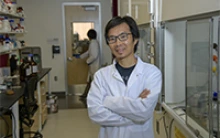UArizona Pharmacy Researcher Identifies Compounds That May Lead to Potential Treatments for COVID-19
Findings on compounds blocking SARS-COV-2 viral replication may offer a starting point for further development of treatments to address the ongoing, devastating novel coronavirus pandemic.

TUCSON, Ariz. – A researcher at the University of Arizona College of Pharmacy has identified four compounds that block the viral replication cycle of SARS-CoV-2, the pathogen that causes COVID-19, providing a promising starting point for further development of potential treatments for this devastating disease.

Jun Wang, PhD, in lab at Skaggs Pharmaceutical Sciences Center, UArizona College of Pharmacy. (Photo: Kris Hanning/University of Arizona Health Sciences)
“Given our promising preliminary data, we are applying structure-based drug design to further optimize the existing compounds to push the efficacy to the limit,” Dr. Wang said.
The primary function of a virus is to replicate by interacting with a host cell. Viral infections are caused when a virus introduces its genetic materials into the cells of its host, “hijacking” the cell’s internal machinery to make more copies of itself. During viral replication, a virus will express a number of proteins, each one playing a different role in the replication cycle. By blocking or inhibiting any one of these proteins the virus loses the ability to replicate, effectively stopping it in its tracks.
In his laboratory team’s study, Dr. Wang focused on finding compounds that inhibited the viral main protease (Mpro), an attractive drug target among coronaviruses because of its essential role in the viral replication cycle. Inhibiting the activity of this enzyme blocks viral replication, preventing the virus from infecting more cells, spreading to a new host and making more people sick.

X-ray crystal structure of the SARS-CoV-2 main protease in complex with GC-376, an investigational veterinary drug used to treat FIP in cats. (Graphic: Laboratory of Jun Wang, PhD/University of Arizona Health Sciences)
Dr. Wang’s lab identified four compounds: boceprevir, GC-376, and calpain inhibitors II and XII, which demonstrated significant antiviral activity against SARS-CoV-2. Boceprevir, an FDA-approved compound used to treat Hepatitis C, already has been through Phase 1 clinical trials. Its effective dose, formulation and toxicity profile are well-known, making it easier for clinicians to begin scheduling clinical trials to evaluate its benefit for COVID-19 patients.
In addition, GC-376, an investigational veterinary drug for treatment of feline infectious peritonitis in cats, also showed promising antiviral activity against SARS-CoV-2 as well as displaying favorable interactions between the body and the drug. Having already demonstrated efficacy in animal-model studies, this compound is ready to be tested in relevant SARS-CoV-2 animal models.
Dr. Wang’s team now is working to find collaborators who can help evaluate the efficacy of both Boceprevir and GC-376 in animal models. As his team waits, his laboratory is exploring the potential for developing their own similar – yet distinct – molecules to test against SARS-CoV-2.
Dr. Wang also is working with Tech Launch Arizona, the commercialization arm of the UArizona that helps move innovations from idea to lab to market, to help patent use of these compounds against SARS-CoV-2.
Learn more about this invention here: Bioactive Compounds for Use in Inhibiting SARS-CoV-2 Viral Replication.
This project was partially funded by NIH/NIAID grant R01-AI147325.
# # #
WRITERS/EDITORS PLEASE NOTE: A preprint of a paper this article is based upon is posted at BioRxiv, a free online archive and distribution service for unpublished preprints in the life sciences. This is a preliminary report and has not been peer reviewed.
NOTE: Photo and image available upon request.
About the University of Arizona College of Pharmacy
The University of Arizona College of Pharmacy is the premier pharmacy college in the Southwest, and one of the top in the nation, focused on drug discovery, toxicology, pharmaceutics, health outcomes and sciences, pharmaceutical education and research through interprofessional training and collaborative public/private partnerships. Preparing pharmacists and pharmaceutical scientists in undergraduate, professional, graduate and post-doctoral programs, the college embraces an entrepreneurial spirit, providing tailored educational opportunities to broaden students' experiences. Established 72 years ago as the first health sciences college at UArizona, the college has a long history of improving science and health, both in Arizona and around the world. It is currently ranked No. 8 among the nation’s 143 colleges of pharmacy by the American Association of Colleges of Pharmacy. For more information: pharmacy.arizona.edu (Follow us: Facebook | Twitter | Instagram | YouTube).
About the University of Arizona Health Sciences
The University of Arizona Health Sciences is the statewide leader in biomedical research and health professions training. UArizona Health Sciences includes the Colleges of Medicine (Tucson and Phoenix), Nursing, Pharmacy, and the Mel and Enid Zuckerman College of Public Health, with main campus locations in Tucson and the Phoenix Biomedical Campus in downtown Phoenix. From these vantage points, Health Sciences reaches across the state of Arizona, the greater Southwest and around the world to provide next-generation education, research and outreach. A major economic engine, Health Sciences employs nearly 5,000 people, has approximately 4,000 students and 900 faculty members, and garners $200 million in research grants and contracts annually. For more information: uahs.arizona.edu (Follow us: Facebook | Twitter | YouTube | LinkedIn | Instagram).

